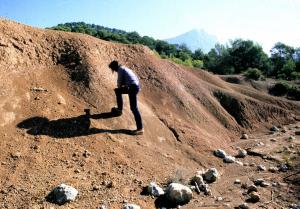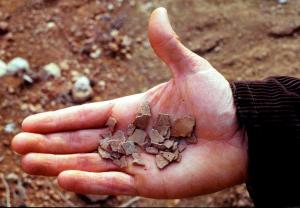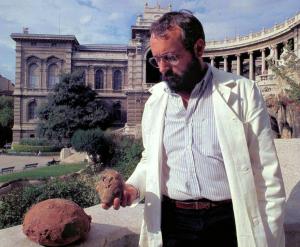Dinosaur eggs à la Sainte-Victoire
Sixty million years ago, what is now Provence was a narrow ribbon of land surrounded by ocean, a mere isthmus connecting the present-day Maures and Massif Central mountain ranges. Mount Sainte-Victoire had not appeared yet, and there was no one to paint it. Hominoids were not due for another 55 million years. Our closest parent then was a tiny mouse with an uncertain future.
The late Cretaceous Period was the realm of dinosaurs. They had been around for some 150 million years and had evolved into hundreds of species; some huge, some small; some carnivorous, others feeding on grass; some who flew and some who ran. They are known to us as Diplodocuses, Triceratopses, Raptors, Pterodactyls, and Titanosauruses, and others.
The Titanosauruses, along with some smaller-size breeds, were at home in the tropical marshes where Mount Sainte-Victoire now stands. There, they would waddle in the mud and build nests to lay their eggs. The "terrible lizards"—which is what the word "dinosaur" means—are long gone, but their fossilized eggs still abound in the massif, some as large as a football.
The egg deposits around Mount Sainte-Victoire have no equivalent in the world. Thousands of fossilized eggs and hundreds of fully-preserved nests have been brought to the surface over the years by palaeontologists and deposited in museums in Aix, Marseille and the villages around the mountain. Others have been sold for a fortune to rich amateurs all over the world.
In some areas of the range, the ground is literally covered with eggshell fragments. It is a strange feeling to hold these tiny, fragile remnants of gigantic animals in your hand. Studying the eggs has shown that in some species there was a factor of 10,000 between the size of the embryo and that of the grown animal.
Walking freely among the eggshell fields is now impossible. A natural reservation was established in 1994 that closes off access to the most spectacular of the deposits. Rangers on horseback patrol the area and one can be severely fined for trying to bring home one of these souvenirs from 65 million years ago. Visits can be organized, however. In the village of Saint-Antonin-sur-Bayon, 10 kilometres east of Aix-en-Provence, the Maison de Sainte-Victoire offers permanent exhibits and guided tours every weekend.
At the Mount Sainte-Victoire, one can travel in time as easily as one travels in art.




